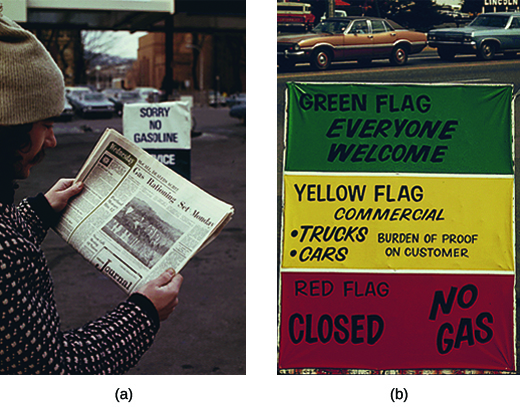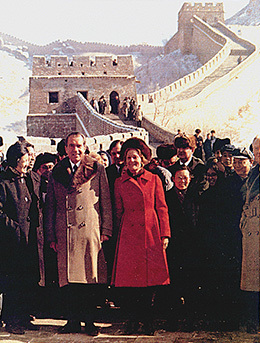| << Chapter < Page | Chapter >> Page > |

Although Nixon’s economic and civil rights policies differed from those of his predecessors, in other areas, he followed their lead. President Kennedy had committed the nation to putting a man on the moon before the end of the decade. Nixon, like Johnson before him, supported significant budget allocations to the National Aeronautics and Space Administration (NASA) to achieve this goal. On July 20, 1969, hundreds of millions of people around the world watched as astronauts Neil Armstrong and Edwin “Buzz” Aldrin walked on the surface of the moon and planted the U.S. flag. Watching from the White House, President Nixon spoke to the astronauts via satellite phone. The entire project cost the American taxpayer some $25 billion, approximately 4 percent of the nation’s gross national product, and was such a source of pride for the nation that the Soviet Union and China refused to televise it. Coming amid all the struggles and crises that the country was enduring, the moon landing gave citizens a sense of accomplishment that stood in stark contrast to the foreign policy failures, growing economic challenges, and escalating divisions at home.
Despite the many domestic issues on Nixon’s agenda, he prioritized foreign policy and clearly preferred bold and dramatic actions in that arena. Realizing that five major economic powers—the United States, Western Europe, the Soviet Union, China, and Japan—dominated world affairs, he sought opportunities for the United States to pit the others against each other. In 1969, he announced a new Cold War principle known as the Nixon Doctrine, a policy whereby the United States would continue to assist its allies but would not assume the responsibility of defending the entire non-Communist world. Other nations, like Japan, needed to assume more of the burden of defending themselves.
Playing what was later referred to as “the China card,” Nixon abruptly reversed two decades of U.S. diplomatic sanctions and hostility to the Communist regime in the People’s Republic of China, when he announced, in August 1971, that he would personally travel to Beijing and meet with China’s leader, Chairman Mao Zedong, in February 1972 ( [link] ). Nixon hoped that opening up to the Chinese government would prompt its bitter rival, the Soviet Union, to compete for global influence and seek a more productive relationship with the United States. He also hoped that establishing a friendly relationship with China would isolate North Vietnam and ease a peace settlement, allowing the United States to extract its troops from the war honorably. Concurring that the Soviet Union should be restrained from making advances in Asia, Nixon and Chinese premier Zhou Enlai agreed to disagree on several issues and ended up signing a friendship treaty. They promised to work towards establishing trade between the two nations and to eventually establishing full diplomatic relations with each other.

Continuing his strategy of pitting one Communist nation against another, in May 1972, Nixon made another newsworthy trip, traveling to Moscow to meet with the Soviet leader Leonid Brezhnev. The two discussed a policy of détente , a relaxation of tensions between their nations, and signed the Strategic Arms Limitation Treaty (SALT), which limited each side to deploying only two antiballistic missile systems. It also limited the number of nuclear missiles maintained by each country. In 1974, a protocol was signed that reduced antiballistic missile sites to one per country, since neither country had yet begun to build its second system. Moreover, the two sides signed agreements to allow scientific and technological exchanges, and promised to work towards a joint space mission.
When a new Republican constituency of moderate southerners and northern, blue-collar workers voted Richard Nixon into the White House in 1968, many were hopeful. In the wake of antiwar and civil rights protests, and the chaos of the 1968 Democratic National Convention, many Americans welcomed Nixon’s promise to uphold law and order. During his first term, Nixon strode a moderate, middle path in domestic affairs, attempting with little success to solve the problems of inflation and unemployment through a combination of austerity and deficit spending. He made substantial progress in foreign policy, however, establishing diplomatic relations with China for the first time since the Communist Revolution and entering into a policy of détente with the Soviet Union.

Notification Switch
Would you like to follow the 'U.s. history' conversation and receive update notifications?